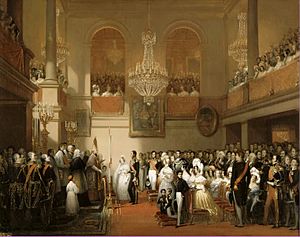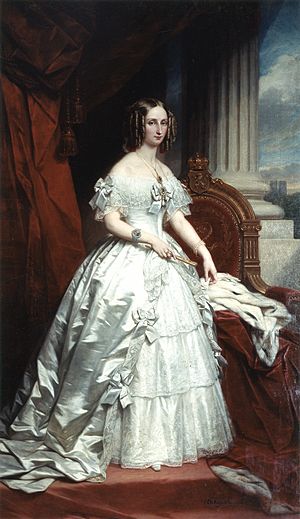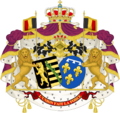Louise of Orléans facts for kids
Quick facts for kids Louise of Orléans |
|||||
|---|---|---|---|---|---|

Portrait by Franz Xaver Winterhalter, 1841
|
|||||
| Queen consort of the Belgians | |||||
| Tenure | 9 August 1832 – 11 October 1850 | ||||
| Born | 3 April 1812 Palermo, Kingdom of Sicily |
||||
| Died | 11 October 1850 (aged 38) Ostend, Kingdom of Belgium |
||||
| Burial | Church of Our Lady of Laeken | ||||
| Spouse | |||||
| Issue |
|
||||
|
|||||
| House | Orléans | ||||
| Father | Louis Philippe I of France | ||||
| Mother | Maria Amalia of the Two Sicilies | ||||
| Religion | Roman Catholicism | ||||
| Signature | |||||
Louise-Marie Thérèse Charlotte Isabelle of Orléans (born 3 April 1812 – died 11 October 1850) was the very first Queen consort of the Belgians. She became queen when she married King Leopold I on 9 August 1832. She was the second child and oldest daughter of Louis Philippe I, who was the King of France, and his wife, Maria Amalia of the Two Sicilies. Queen Louise was quite shy and did not often appear in public. However, she was a trusted advisor to her husband, King Leopold I. Her many letters are a great source of information for historians today.
Contents
Early Life and Education
Louise was born in Palermo, Sicily, on 3 April 1812. Her father later became King Louis-Philippe I of the French. Her mother was Maria Amalia of the Two Sicilies. From a young age, Louise received a very religious and proper education. Her mother and her aunt, Princess Adélaïde of Orléans, played a big part in this. Louise was very close to her aunt, who made sure she had a strict religious upbringing. She also learned to speak several languages, including English, German, Dutch, and Italian.
As a member of the royal House of Orléans, Louise was considered a Princess of the Blood Royal. This meant she was part of the main royal family.
Becoming a Queen
In 1830, a big event called the July Revolution happened in France. This led to her father becoming the King of the French. This changed Louise's life, as she was now the eldest daughter of a king.
On 9 August 1832, when Louise was 20 years old, she married King Leopold I of the Belgians. Leopold was 22 years older than her. Their wedding took place at the Compiègne Palace. Leopold had been married before, but his first wife, Princess Charlotte of Wales, had died in 1817. Because Leopold was a Protestant, they had two wedding ceremonies: one Catholic and one Calvinist.
This marriage was important because it created a connection between two new kings. Both Louise's father and her husband had recently become monarchs. Louise's mother was not happy about the marriage because Leopold was a Protestant. However, it was seen as a good match for Louise's family. It helped the new French royal family gain more respect from other established royal families.
Louise was not happy about leaving France and her family. But Leopold treated her with kindness and respect from the very beginning. This made Louise feel much better, and soon their marriage became a happy one. Louise was known as a devoted wife and a loving mother. She was naturally shy, and her husband preferred her to live a quiet family life. She spent her time raising her children. She also enjoyed reading to Leopold from famous authors like Stendhal, Chateaubriand, Byron, and Shakespeare.
Queen Louise's Public Role
Queen Louise was described as a shy person with delicate health. Belgium was a new country, and there were no clear rules for what a queen should do. King Leopold believed that royal family members should not appear in public too often. So, he did not create a big public role for Louise as queen.
Queen Louise was rarely seen in public. Her life mostly revolved around raising her children, writing letters to her family in France, and her religious duties. She had four ladies-in-waiting who were her companions.
Even though the king did not like public appearances, he often held private parties at the royal Palace of Laeken. These events included receptions, balls, and banquets for important people. At first, most guests were British, as many Belgian nobles were still loyal to the previous royal family. But over time, more Belgian nobles started to attend. These parties were almost the only times Louise met people in Belgium. Among this small group, she slowly became less shy and seemed to enjoy the costume balls.
Every morning, Queen Louise received requests for money from people who needed help. She would then visit their homes herself to offer comfort and financial aid. Sometimes, she would even borrow money from her ladies-in-waiting to help others, without telling her husband. She also supported the lace-making industry, which was struggling. Her financial help to a lace-making school greatly improved the business.
King Leopold eventually allowed Louise to travel around Belgium. Her favorite places were the coastal towns in Flanders, especially Oostende. There, she enjoyed horse riding, swimming in the sea, and walking on the beach to collect seashells. She was rarely allowed to travel outside Belgium. For example, Leopold did not take her to London in 1841, even though she wanted to go. However, he did take her to Paris to visit her parents in 1841. She also met Queen Victoria of Great Britain in 1843. In 1844, she celebrated her birthday with Queen Victoria at Buckingham Palace.
Even though Queen Louise was shy and rarely seen in public, she had strong opinions in private. She was very interested in political matters. Over time, King Leopold began to ask for her advice on state affairs, especially about diplomacy. He trusted her so much that he even suggested she become the official regent when he was away. However, this idea was not supported by others, so he had to change his plans.
Queen Louise received a lot of sympathy in Belgium when her parents lost their throne during the French Revolution of 1848. She visited her exiled parents in England in October of that year. The revolution in France made the Belgian king and queen more popular in Belgium. They toured the Belgian provinces and were welcomed with great enthusiasm.
Death
Queen Louise became ill with tuberculosis and passed away in the former Royal palace of Ostend on 11 October 1850. Her death was officially confirmed by ministers Charles Rogier and Victor Tesch. Her body was brought to Laeken, and a memorial was built in Oostende. She is buried next to her husband in the Royal Crypt of the Church of Our Lady of Laeken.
Children
Louise and Leopold had four children:
- Prince Louis Philippe, Crown Prince of Belgium (born 24 July 1833 – died 16 May 1834)
- King Leopold II of the Belgians (born 9 April 1835 – died 17 December 1909)
- Prince Philippe, Count of Flanders (born 24 March 1837 – died 17 November 1905)
- His son later became King Albert I of the Belgians.
- Princess Charlotte of Belgium (born 7 June 1840 – died 19 January 1927), who married Emperor Maximilian I of Mexico.
Images for kids
See also
 In Spanish: Luisa María de Orleans para niños
In Spanish: Luisa María de Orleans para niños







